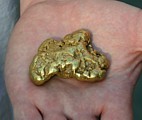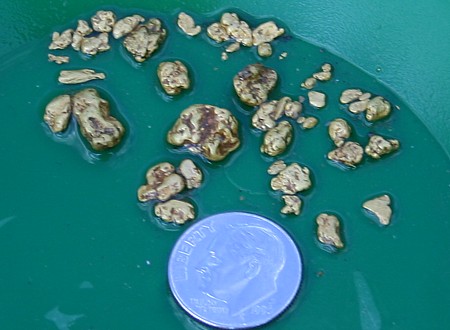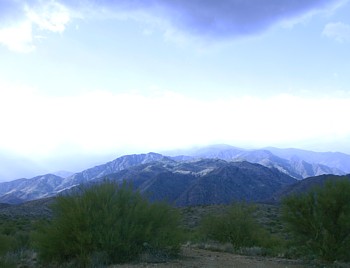Bradshaw Mountains In Arizona

.

Bradshaw Mountains In Arizona |
 |
||
|
. |
Interested in finding some Arizona gold? The many gold districts of the Bradshaw Mountain range are a great place to use a metal detector and I have found some nice nuggets here myself, even though I've only come for a few visits. The Bradshaws are a beautiful place to camp out and explore, as this range has a long history of productive gold mining for both hard rock and placer gold. For more information about finding your own gold here, take a look at the following information....... |
 |
|
| The Bradshaw Range in central
Arizona gives rise to a number of important gold districts all along it's length. The gold
districts located in the Bradshaw range are among the most productive placer fields in the
state, and still yield gold to individual prospectors working there. Important gold
districts in this area include Lynx Creek, the Big Bug Creek area, the upper Hassayampa
River system, the Groom Creek placers, the Black Canyon placers and several others. Perhaps the first discovery of gold in the Bradshaw range was made at Lynx Creek in 1863 by a party of California miners headed by Captain Joe Walker. Lynx Creek was very rich in certain areas, and successful prospectors recovered an ounce or more per day in the early days. Word spread and additional miners came to work the area. Over the next five to 10 years, additional placer deposits were discovered in many other creeks draining the Bradshaw mountain range, with the highest period of placer mining activity occurring in the 1870s and 1880s. At times, several hundred men were working in the various gold districts around the Bradshaw range. Dredging was done along Lynx Creek in the early part of the 1900s. |
|
|
| While some of the early mining work in this
area was done by sluicing or rocking during the times and seasons when water was
available, the vast majority of the work placer mining in this area has been done by
dry washers, at least until recent years. Virtually all of the dry washing here has been done
by small scale miners who travel from site to site searching for richer deposits and
pockets of gold. In more recent times, metal detecting has become very important method
for finding
gold in the Bradshaw range, and metal detector operators commonly rework the
tailings piles of older dry washing operations for missed nuggets. Because of its proximity and easy access from Phoenix, there are many private placer claims which have been located in the Bradshaw range. There are also some club claims located here, which provide access for prospectors who belong to those clubs. Additionally there is also a significant amount of private land, especially the lands closer to Highway 17. These areas are undergoing continued real estate development and more and more new homes are being constructed in the area. the for service has placed numerous restrictions concerning prospecting on Lynx Creek. Before attempting to prospect in the Bradshaw mountains area, it is important to know the land and claim status of the are you intend to explore. |
 A Quarter ounce of Bradshaw Mountains gold. |
|
|
||
| The placer geology of the Bradshaw
Range focuses on a Precambrian schist, granite and other intrusive rocks. These older
rocks are part of the main North American crustal plate, and have been brought to the
surface in the Bradshaw mountains by geologic uplift. While there are some younger
tertiary volcanic rocks such as basalt which cover the hills and mountains in certain
areas, the older Precambrian rocks are underneath. Many of the most productive districts
are underlain by a Precambrian schist known to prospectors as the Yavapai schist.
Precambrian to tertiary age
gold quartz veins within the schist and granite rocks provide the
gold which erosion has concentrated into the placer deposits. While there is some nice
coarse gold to be found at various locations in the Bradshaw mountains, many of the
gold nuggets found there tend to
be on the small side. As far as the coarsest gold, nuggets of about four to five ounces in
size are usually about the maximum obtained in the Bradshaw area. Along most of the creeks
the coarsest gold tends to be found in the upstream portions of the creeks, while in
the lower reaches of the streams fine gold predominates. The gold is widespread at many locations in the Bradshaw range, and many smaller tributary gullies and ravines have been worked for their placer gold, but these smaller deposits do not appear in any reports or other documentation. Rediscovery of these smaller streams has led to some excellent discoveries by prospectors armed with metal detectors. Areas which present good potential for prospecting can be identified using geologic maps and selecting the areas where the Yavapai Precambrian schist outcrops. |
||
| Getting to the Bradshaw Mountains area is
fairly easy, but getting into the remote parts of the interior of the range is not.
Highway 17, which goes north from Phoenix skirts the east side of the range and in many
locations provides the best access. From Highway 17, a large number of dirt roads,
including both maintained and un-maintained pathways, crisscross through the Bradshaw
range. In some places, roadways which seem to be in good condition may quickly deteriorate
into pathways which are simply impassable. It is important to exercise extra care
when driving through these areas on unfamiliar roads. Prescott is the largest town in the Bradshaw range area, and has a full range of services and supplies. Some communities near Highway 17 have available supplies, but many of the smaller communities such as Cleator do not offer much beyond cold drinks. It is best to bring in one's own food and supplies when looking to go prospecting in the Bradshaw range. |
 |
|
|
|
||
.
Want to know a little bit more about this crazy prospector guy? Well, here's a little bit more about me, and how I got into prospecting: Chris' Prospecting Story